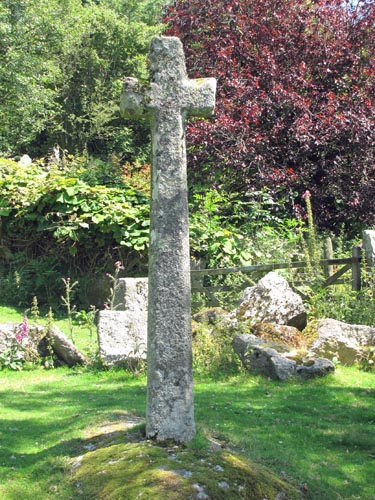 Location:
On the village green, just below the private house named –
‘The Old National School’. Location:
On the village green, just below the private house named –
‘The Old National School’.
O/S Grid Ref: SX/53374/72449 Longitude/Latitude (Degrees+/-): -4.07030/50.53338 Map location: Click here to view map. Purpose: Village Cross. Size: 7 feet 2 inches (2.20 metres) tall. 1 foot 7 inches (0.50 metres) across the arms. Information: The setting around the cross is as fine as one could expect to see, even around the borders of Dartmoor. Behind the cross are the village church and the old school, which has now been converted into a private house. A nice little stream trickles its way across the green and runs just below the foot of the cross.
The 13th century church, dedicated to St Mary, is plain and simple in design. It was enlarged during the 16th century and is thought to have an interesting piece of wood carving behind a side altar. It is set, almost hidden one could say, amongst the trees and has the thoughtful addition of a ‘bird bath’ near the front porch. This is a square granite stone, built into the top of a rough boulder, which has been hollowed out. The stone measures 23½ inches wide, 22 inches deep and 6 inches high. The hollow measures 14 inches square and 3 inches deep. In the supporting boulder there are 4 holes, one in each corner, which would each take a jar for flowers. Attached to this boulder is a memorial plaque, which reads as follows: On the other
side of the green is the ancient Manor
House, which boasts a fine stone arch
leading up to the front entrance. This is still a working When Drake died, 1596, he didn't have any natural heirs and left his whole estate to his second-in-command, Jonas Bodenham, whom he had always treated as a son. Bodenham held on to the property for a while but eventually sold it to Drake's brother, Thomas. The house was rebuilt in 1607 and completed restored in 1935, when it became Hall Farm, named after its then owner, the Reverend John Hall Parlby. By 1987, it had again fallen into disrepair and was bought by the Pugh family, who had the property completely refurbished with the assistance of English Heritage. The 5 bedroom house is now thought to be worth in the region of £1.25 million. The lands of Sampford Spiney were the furthest away of those belonging to the Plympton Priory in this direction. Monks from the priory, who were visiting Tavistock Abbey, would often call at Sampford Spiney on their way. This would involve leaving the Plympton Track at Huckworthy Bridge, crossing Huckworthy Common and passing the Huckworthy Common Cross on the way. It had been suggested that the name of ‘Spiney’ was derived from Spinetum, which means a thornbrake (thicket of thorns). However, William Crossing wrote that the manor was once in the family of Spinet, or de Spineto, and that the variation of this name has been added to that of ‘Sampford’. |